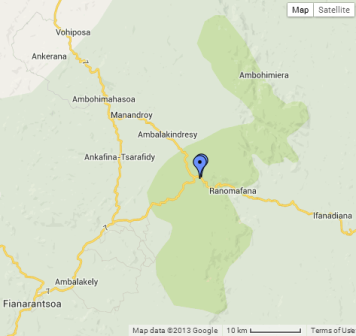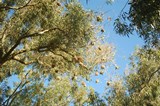PAPER: Breeding study of fodies in Madagascar 2013-11-04 (443)
Solohery RA, Aristide A. 2013. First breeding survey of the endemic Madagascar Red Fody Foudia madagascariensis and Forest Fody Foudia omissa at Ranomafana National Park, Madagascar. Vertebrate Zoology 63(2): 233-240.
 Abstract. An intensive study of the breeding biology of Foudia madagascariensis and Foudia omissa in the family Ploceidae was first conducted in Ranomafana National Park from November 2003 to April 2004. During the survey, 368 nests of Foudia madagascariensis and 7 nests of Foudia omissa were found. Nest building of F. madagascariensis can be divided into four stages. The male builds the nest up to stage 2. Then the female partner finishes construction of the nest until stage 4. In both species incubation lasts 13 to 17 days and the number of eggs varies from 1 to 5 per brood for F. madagascariensis and 1 to 3 for F. omissa. Males of both species occupied more than one nest in their territory and had at least three different partners, thus are apparently polygamous. They defend their territory and rarely feed their chicks or engage in parental care at all. The females ensure incubation of the eggs, clean the nest and rear the chicks. The nestlings first flew out after 13 to 15 days and were consecutively led by the parents. During the study period a cyclone and especially anthropogenic nest destruction contributed to 26% of nest failures.
Abstract. An intensive study of the breeding biology of Foudia madagascariensis and Foudia omissa in the family Ploceidae was first conducted in Ranomafana National Park from November 2003 to April 2004. During the survey, 368 nests of Foudia madagascariensis and 7 nests of Foudia omissa were found. Nest building of F. madagascariensis can be divided into four stages. The male builds the nest up to stage 2. Then the female partner finishes construction of the nest until stage 4. In both species incubation lasts 13 to 17 days and the number of eggs varies from 1 to 5 per brood for F. madagascariensis and 1 to 3 for F. omissa. Males of both species occupied more than one nest in their territory and had at least three different partners, thus are apparently polygamous. They defend their territory and rarely feed their chicks or engage in parental care at all. The females ensure incubation of the eggs, clean the nest and rear the chicks. The nestlings first flew out after 13 to 15 days and were consecutively led by the parents. During the study period a cyclone and especially anthropogenic nest destruction contributed to 26% of nest failures.
Two study sites, Vohiparara and Sahamalaotra, were chosen within Ranomafana National Park. The paper includes photos of the nests of the Madagascar Red Fody. Tables provide information on breeding success and clutch size in both fody species, and nest dimensions for the Madagascar Red Fody. By colour ringing adults, the authors show that these fodies are polygamous, contra the thought that they were monogamous (see breeding summary at Madagascar Red Fody and Forest Fody).
Literature as featured in Weaver Watch news items
| 










 Abstract. An intensive study of the breeding biology of Foudia madagascariensis and Foudia omissa in the family Ploceidae was first conducted in Ranomafana National Park from November 2003 to April 2004. During the survey, 368 nests of Foudia madagascariensis and 7 nests of Foudia omissa were found. Nest building of F. madagascariensis can be divided into four stages. The male builds the nest up to stage 2. Then the female partner finishes construction of the nest until stage 4. In both species incubation lasts 13 to 17 days and the number of eggs varies from 1 to 5 per brood for F. madagascariensis and 1 to 3 for F. omissa. Males of both species occupied more than one nest in their territory and had at least three different partners, thus are apparently polygamous. They defend their territory and rarely feed their chicks or engage in parental care at all. The females ensure incubation of the eggs, clean the nest and rear the chicks. The nestlings first flew out after 13 to 15 days and were consecutively led by the parents. During the study period a cyclone and especially anthropogenic nest destruction contributed to 26% of nest failures.
Abstract. An intensive study of the breeding biology of Foudia madagascariensis and Foudia omissa in the family Ploceidae was first conducted in Ranomafana National Park from November 2003 to April 2004. During the survey, 368 nests of Foudia madagascariensis and 7 nests of Foudia omissa were found. Nest building of F. madagascariensis can be divided into four stages. The male builds the nest up to stage 2. Then the female partner finishes construction of the nest until stage 4. In both species incubation lasts 13 to 17 days and the number of eggs varies from 1 to 5 per brood for F. madagascariensis and 1 to 3 for F. omissa. Males of both species occupied more than one nest in their territory and had at least three different partners, thus are apparently polygamous. They defend their territory and rarely feed their chicks or engage in parental care at all. The females ensure incubation of the eggs, clean the nest and rear the chicks. The nestlings first flew out after 13 to 15 days and were consecutively led by the parents. During the study period a cyclone and especially anthropogenic nest destruction contributed to 26% of nest failures.